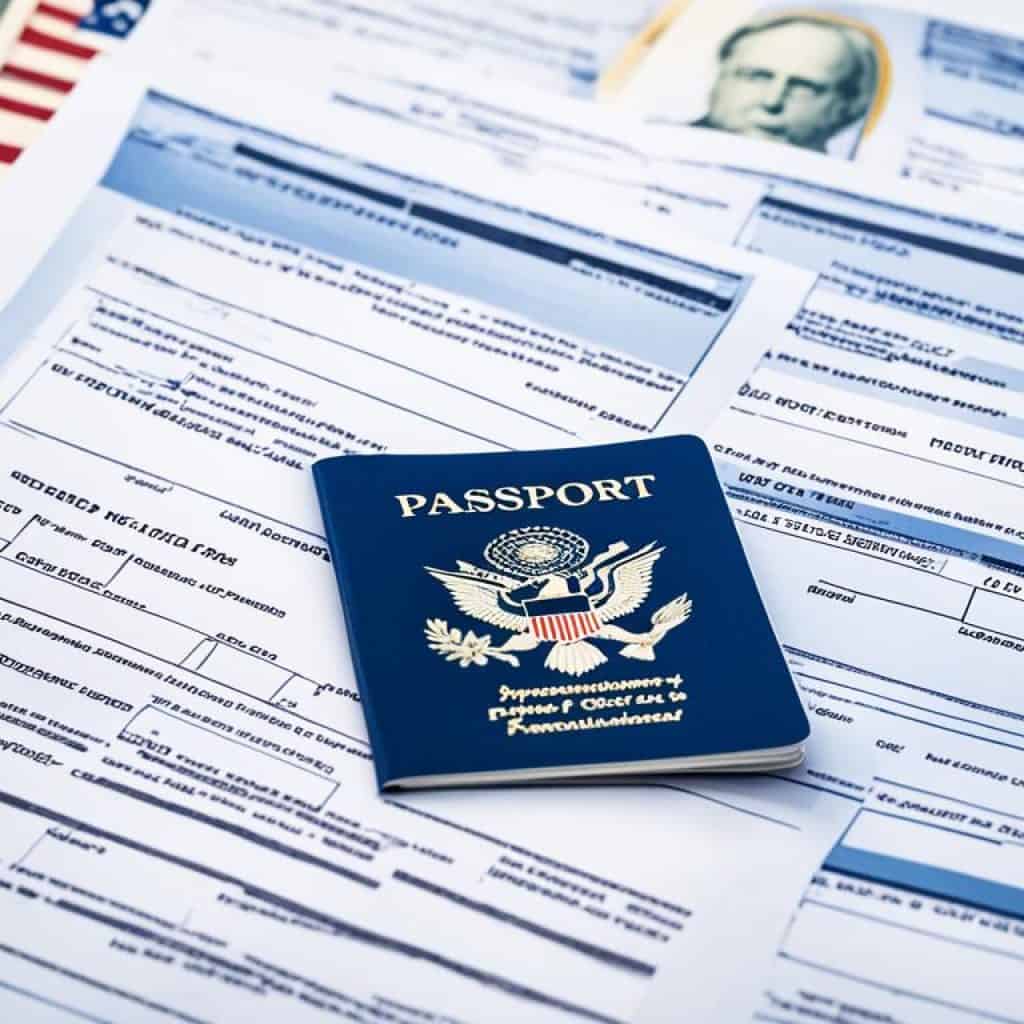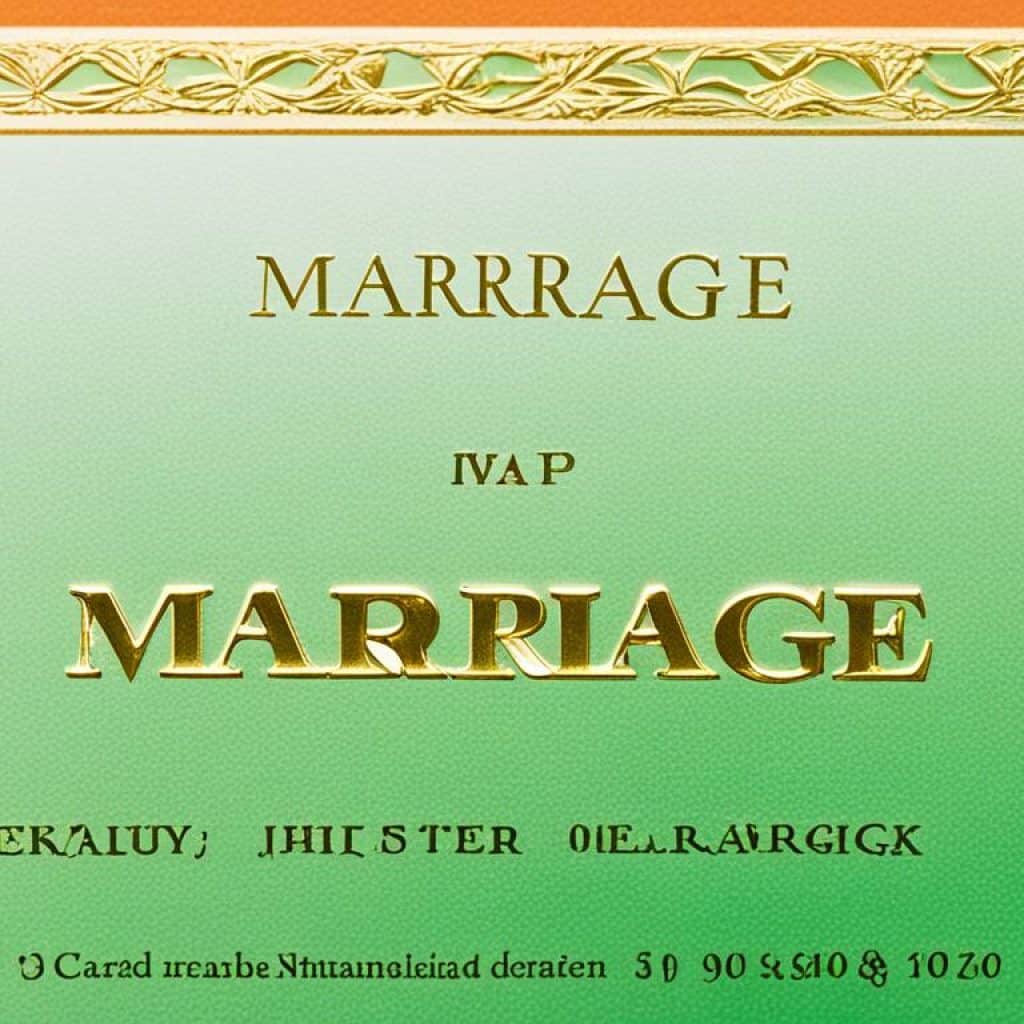Are you a U.S. citizen planning to bring your fiancé(e) to the United States? The K1 visa process might seem complex, but fear not! In this quick and simple guide, we will walk you through the Visa K1 process, from the requirements to the timeline, ensuring that you have all the information you need to make the journey smooth and successful.
Applying for a K1 visa involves several steps and requirements, but understanding the process is essential to ensure a successful outcome. From filing the initial petition to attending the visa interview, there are specific guidelines to follow. Additionally, we’ll explore the necessary documents, processing time, and the next steps after the visa is obtained.
So, let’s dive in and demystify the Visa K1 process. Are you ready to bring your loved one to the USA?
Key Takeaways:
- Learn the step-by-step process of obtaining a K1 visa, from filing the initial petition to getting married within 90 days of arrival.
- Understand the requirements and eligibility criteria for the K1 visa, including proof of relationship authenticity and meeting in person within the two years prior to application.
- Discover the necessary documents and supporting evidence needed for a successful K1 visa application.
- Explore the processing time and denial rate for the K1 visa, and why careful preparation is crucial for success.
- Get insights into the cost of the K1 visa and the next steps after marriage, including applying for a marriage-based green card.
K1 Visa Process: Step by Step Guide
The K1 visa process is a series of steps that must be carefully followed in order to obtain the visa. In this section, we will outline the key stages of the process, from filing the initial application to attending the visa interview.
Step 1: Filing Form I-129F
The first step in the K1 visa process is to file Form I-129F, also known as the Petition for Alien Fiancé(e), with U.S. Citizenship and Immigration Services (USCIS). This form serves as the official request to bring your foreign fiancé(e) to the United States for the purpose of getting married.
To complete Form I-129F, you will need to provide evidence of the authenticity of your relationship. This may include photographs of you and your fiancé(e) together, travel itineraries showing that you have met in person, and letters from family and friends supporting your relationship.
Step 2: Approval and Forwarding
Once your I-129F petition is approved by USCIS, it is forwarded to the National Visa Center (NVC) and then to the U.S. embassy or consulate in your fiancé(e)’s home country. This process may take several weeks or months, depending on the workload of the agencies involved.
Step 3: DS-160 Form and Visa Interview
After your fiancé(e) receives notification from the embassy or consulate, they will need to complete the online DS-160 form. This form collects biographic information and establishes eligibility for a nonimmigrant visa.
Once the DS-160 form is submitted, your fiancé(e) will be scheduled for a visa interview at the U.S. embassy or consulate. During the interview, the consular officer will ask questions to determine the authenticity of your relationship and assess whether the visa should be approved.
Step 4: Entering the U.S. and Getting Married
If the visa is approved, your fiancé(e) will receive the K1 visa and can then enter the United States. It is important to remember that they must get married to you, the U.S. citizen sponsor, within 90 days of their arrival in the U.S.
Getting married within the 90-day window is a crucial requirement to maintain legal status in the U.S. After the marriage, you can begin the process of applying for a marriage-based green card if you wish to establish permanent residence in the country.
Following these steps carefully and providing all necessary documentation will help ensure a smooth and successful K1 visa process. It is recommended to consult with an experienced immigration attorney or reliable immigration service to guide you through the process and maximize your chances of approval.
K1 Visa Requirements and Eligibility
1. Sponsoring Fiancé(e) Requirements
The U.S. citizen sponsor plays a significant role in the K1 visa process. The sponsoring fiancé(e) must:
- Be a U.S. citizen
- Be unmarried and legally able to marry
- Meet certain income requirements
If the U.S. citizen sponsor does not meet the income requirements, a joint sponsor can be used to meet the financial obligations.
2. Authenticity of the Relationship
To establish the authenticity of the relationship, certain pieces of evidence must be provided. This includes:
- Proof of meeting in person within the two years prior to filing the application
- Documentation demonstrating the genuineness of the relationship, such as photographs, travel itineraries, and letters of support from family and friends
It’s important to note that online meetings, video chats, and phone calls do not satisfy the requirement of in-person meetings, unless specific exemptions apply.
3. Eligibility of Same-Sex Partners
| K1 Visa Requirements | Eligibility |
|---|---|
| U.S. Citizen Sponsor | U.S. citizen Unmarried and legally able to marry Meets income requirements or has a joint sponsor |
| Authenticity of Relationship | Physical meeting within two years Proof of relationship genuineness |
| Same-Sex Partners | Eligible, regardless of home country laws |
Documents Required for a K1 Visa
When applying for a K1 visa, it is essential to gather and submit the necessary documents as evidence of your eligibility. These documents play a crucial role in proving the authenticity of the relationship and fulfilling the requirements set by U.S. Citizenship and Immigration Services (USCIS).
Important K1 Visa Checklist:
- Proof of U.S. Citizenship: Provide a copy of your passport or birth certificate as evidence of your U.S. citizenship.
- Foreign Fiancé(e)’s Passport: Include a copy of your foreign fiancé(e)’s passport to establish their identity.
- Evidence of Authenticity: Gather photos, travel itineraries, and letters of support that demonstrate the authenticity of your relationship.
- Proof of In-person Meeting: Include evidence that you and your fiancé(e) have met in person within the two years before filing the application. This can include travel records, hotel reservations, or any other documents that verify your meeting.
- Form I-94 Arrival/Departure Records: Include a copy of all previously issued Form I-94 arrival/departure records to establish your fiancé(e)’s immigration history.
- Passport-style Photos: Both partners must provide passport-style photos that meet the U.S. visa photo requirements.
- Sworn Statement: Sign a sworn statement affirming your intent to marry within 90 days of your fiancé(e)’s arrival in the U.S.

Submitting all the required documents is crucial to ensure that your K1 visa application is complete and stands the best chance of approval. Make sure to review the checklist and double-check that you have included all the necessary paperwork.
Remember, each case is unique, and additional documents may be requested by USCIS or the U.S. embassy or consulate. It is essential to stay updated with the latest requirements and instructions provided by the official government sources.
K1 Visa Processing Time and Denial Rate
One of the key factors to consider when applying for a K1 visa is the processing time. On average, the K1 visa process takes around 6 months from the time of filing Form I-129F to receiving approval. However, it is important to note that the processing time can vary depending on individual cases and the workload of the U.S. Citizenship and Immigration Services (USCIS). The timeline for some applicants may be shorter, while others may experience a longer wait.
It is crucial to carefully prepare the application and provide all necessary supporting documents to avoid any delays in the process. Any missing or incomplete information can result in a rejection or request for additional evidence, further prolonging the processing time.
In FY 2022, the denial rate for K1 visas was approximately 19.7% for Form I-129F applications. This highlights the importance of thorough preparation and attention to detail when applying for a K1 visa. Failure to meet the eligibility criteria, provide sufficient evidence of the authenticity of the relationship, or fulfill the required documentation can lead to a denial.
| K1 Visa Processing Time and Denial Rate | |
|---|---|
| Average Processing Time | Approximately 6 months |
| Denial Rate | 19.7% (FY 2022) |
These statistics emphasize the need for meticulous preparation and attention to detail throughout the K1 visa application process. By ensuring all requirements are met and all necessary documentation is provided, applicants can increase their chances of a successful outcome.
K1 Visa Costs and Fees
Obtaining a K1 visa is an important step towards building a future with your fiancé(e) in the United States. However, it’s essential to understand the associated costs and fees involved in the process.
Cost Breakdown
Let’s break down the expenses related to the K1 visa:
| Fee | Amount |
|---|---|
| Form I-129F Filing Fee | $535 |
| Medical Exam Fee | Approximately $200 |
| K1 Visa Application Fee | $265 |
Please note that these fees only cover the essential requirements and application process. You may incur additional costs, such as translating and photocopying documents or obtaining necessary documentation like a birth certificate. It’s essential to plan for these extra expenses to avoid any financial surprises along the way.
Additional Considerations
While the K1 visa costs are vital to consider, it’s also important to remember that obtaining the K1 visa is just the first step in the process of becoming a permanent resident in the United States. After getting married on a K1 visa, you’ll need to apply for a marriage-based green card, which comes with its own set of costs and requirements.
Preparing for the next steps in your journey, such as applying for a marriage green card, can help you plan ahead and navigate the immigration process more smoothly.
Ensuring you have a clear understanding of the costs and fees involved in the K1 visa process will help you budget accordingly and avoid any financial setbacks. Remember to consult with an experienced immigration service provider or attorney to guide you through the process and ensure a successful outcome.
Meeting the Two-Year Rule for K1 Visas
The success of a K1 visa application hinges on meeting the strict requirements set by the United States Citizenship and Immigration Services (USCIS). One such requirement is the two-year rule, which necessitates that the U.S. citizen sponsor and the foreign fiancé(e) have physically met in person at least once within the two years before filing the K1 visa application.
This provision is crucial in ensuring the authenticity and sincerity of the relationship. While online meetings, video chats, and phone calls contribute to maintaining a connection, they do not fulfill the requirement for an in-person meeting. However, USCIS acknowledges that certain circumstances, such as religious or cultural traditions, or instances where a meeting would result in severe hardship for the foreign fiancé(e), may warrant exceptions to this rule.
If the U.S. citizen sponsor and their foreign fiancé(e) were unable to meet in person within the last two years, they can request a waiver of the two-year rule. To obtain this waiver, they must provide compelling evidence that arranging the meeting was extremely difficult or impossible. Each case is thoroughly reviewed, and USCIS takes into account various factors, including the circumstances surrounding the inability to meet.

Preventing Fraud and Protecting Genuine Relationships
The two-year rule plays a vital role in preventing visa fraud and safeguarding the integrity of the K1 visa program. By necessitating an in-person meeting, USCIS seeks to ensure that the relationship is genuine and not entered into solely for immigration purposes. This requirement helps protect individuals from potential exploitation or fraudulent relationships.
Meeting the two-year rule for K1 visas demonstrates the commitment and validity of the relationship, providing USCIS with a basis for approval. It is an essential step in the process and underscores the significance of genuine connections and shared experiences.
Requesting a Waiver of the Two-Year Rule
To request a waiver, the U.S. citizen sponsor and the foreign fiancé(e) must submit Form I-129F, the petition for Alien Fiancé(e), along with supporting documentation that substantiates their claim for the waiver. This evidence should clearly illustrate the extreme difficulty or impossibility of meeting in person.
Some examples of evidence that may strengthen a waiver request include:
- Affidavits from family members or friends explaining the challenges faced in arranging the meeting
- Medical documentation showcasing severe illness or disability that prevented travel
- Proof of religious or cultural customs that prohibit or impede in-person meetings
A compelling and well-documented waiver request increases the likelihood of USCIS granting the waiver, but it is crucial to consult with an experienced immigration attorney or reputable immigration service to ensure a strong and persuasive submission.
| Key Considerations: | Meeting the Two-Year Rule for K1 Visas | Requesting a Waiver of the Two-Year Rule |
|---|---|---|
| Requirement | U.S. citizen sponsor and foreign fiancé(e) must meet in person at least once within the two years before filing the K1 visa application. | Provide evidence that arranging the meeting was extremely difficult or impossible. |
| Purpose | Ensures the authenticity and sincerity of the relationship. | Allows exceptions for religious or cultural traditions and cases of severe hardship. |
| Documentation | Proof of meeting, such as travel records, photos, and witness statements. | Supporting evidence, such as affidavits, medical documentation, or proof of religious or cultural customs. |
| Expert Assistance | Consult an experienced immigration attorney or reputable immigration service for guidance on meeting the requirement. | Seek professional advice to ensure a strong waiver request and persuasive submission. |
Applying for a K1 Visa Waiver
If the U.S. citizen sponsor and their foreign fiancé(e) did not meet in person within the two years before filing the K1 visa application, they may request a waiver of the two-year rule. This request should be submitted with Form I-129F and must include evidence that arranging the meeting was extremely difficult or impossible. Each case is reviewed individually, and USCIS will consider factors such as religious or cultural traditions, as well as any severe hardship that meeting in person would cause to the foreign fiancé(e).
| Steps to Apply for K1 Visa Waiver | Documents Required |
|---|---|
| 1. Submit Form I-129F with K1 visa waiver request | – Form I-129F |
| 2. Provide evidence of difficulty or impossibility in meeting the two-year rule | – Detailed explanation of circumstances – Supporting documents (e.g., medical records, official statements) |
| 3. Await USCIS review and decision | – None |
| 4. If approved, proceed with the K1 visa process | – – |
| 5. If denied, explore alternative visa options | – – |
Note: Each K1 visa waiver request is evaluated on a case-by-case basis, and USCIS takes into account the unique circumstances and hardships faced by the couple. It is crucial to provide compelling evidence and a detailed explanation of why meeting the two-year rule was difficult or impossible.
Seeking assistance from an experienced immigration attorney or reputable immigration service can be beneficial, as they can guide you through the process, help gather the necessary evidence, and ensure that your request is strong and persuasive.
Applying for a K1 visa waiver requires careful attention to detail and thorough documentation. It is crucial to present a compelling case to demonstrate the extreme difficulty or impossibility in meeting the two-year rule. With the right preparation and support, you can increase your chances of obtaining a K1 visa waiver and continue your journey to being together with your fiancé(e) in the United States.
Getting Married on a K1 Visa
Once the foreign fiancé(e) enters the United States on a K1 visa, they have 90 days to get married to their U.S. citizen sponsor. It is crucial to plan and prepare for the wedding within this time frame to ensure compliance with the visa requirements and avoid any complications. The K1 visa is specifically designed for the purpose of marriage between the foreign fiancé(e) and the U.S. citizen sponsor, so it is essential to fulfill this commitment within the given timeframe.
If the couple decides not to proceed with the marriage, the foreign fiancé(e) must leave the country before the K1 visa expires. It’s important to note that the K1 visa does not allow for a change to another travel visa or for the adjustment of status to a marriage-based green card with a different sponsor. The sole purpose of the K1 visa is for the foreign fiancé(e) to enter the U.S. and marry their U.S. citizen sponsor.
Planning a wedding within the 90-day window can be both exciting and challenging. Couples should consider factors such as venue selection, guest invitations, and legal formalities to ensure a smooth and memorable wedding experience. Collaborating with wedding planners, family members, and friends can help alleviate some of the stress and ensure a successful celebration of their union.
Important Considerations for Getting Married on a K1 Visa:
- Secure the necessary legal documentation for marriage in the state where the wedding will take place.
- Arrange for witnesses to be present during the ceremony, as required by local laws.
- Ensure that the wedding ceremony takes place within the 90-day window of the K1 visa.
- Inform family and friends about the wedding date and location well in advance.
- Consider cultural traditions and incorporate them into the wedding ceremony and reception.
Getting married on a K1 visa is an important milestone for couples looking to establish their lives together in the United States. It marks the beginning of their journey as a married couple and sets the stage for future steps, such as applying for a marriage-based green card to obtain permanent residence. Planning and executing a beautiful and meaningful wedding within the given timeframe is an exciting endeavor that showcases the couple’s commitment to each other and their shared future.
| Pros | Cons |
|---|---|
|
|
Applying for a Marriage Green Card after a K1 Visa
Once you have gotten married on a K1 visa, the next crucial step is to apply for a marriage-based green card. This process will allow you to establish permanent residence in the United States and continue your life with your spouse.
To apply for a marriage green card, you will need to complete and file Form I-485: Application to Register Permanent Residence or Adjust Status, along with the required supporting forms and documents. It is important to ensure that you have all the necessary paperwork in order to avoid any delays or complications in the application process.
The cost for applying for a marriage green card is $1,225, which includes the USCIS filing fee and the biometrics fee. This amount is subject to change, so it’s essential to check the current fee schedule at the time of application.
After submitting your application, it typically takes around 4-6 months to receive the marriage green card. This timeframe can vary depending on various factors, including USCIS processing times and the complexity of your case. It is important to be patient and proactive during this waiting period.
Note: The sponsor for the marriage green card must be the same as the U.S. citizen sponsor who initially sponsored the K1 visa. This ensures continuity and consistency in the immigration process.
While waiting for your marriage green card, you can apply for work authorization by filing Form I-765: Application for Employment Authorization. This will allow you to legally work in the United States while your green card application is being processed. It’s worth noting that the work authorization is valid for 90 days and cannot be extended without further steps, such as obtaining the marriage green card.

Marriage Green Card Document Checklist
Before submitting your application for a marriage green card, it’s vital to ensure that you have all the required supporting documents. Here is a checklist of essential documents:
| Documents | Details |
|---|---|
| Form I-485: Application to Register Permanent Residence or Adjust Status | Completed and signed |
| Supporting Forms | Any additional forms required for your case |
| Marriage Certificate | Demonstrating the legal marriage between the U.S. citizen and foreign spouse |
| Proof of Identity | Valid passport or government-issued identification |
| Proof of Legal Entry | Copy of your K1 visa and I-94 Arrival/Departure Record |
| Proof of Financial Support | Form I-864: Affidavit of Support and supporting financial documents |
| Proof of Relationship | Photos, joint financial documents, lease agreements, or any other evidence of a bona fide marriage |
It is crucial to review the official USCIS website and consult with an immigration attorney to ensure that you have all the necessary documentation specific to your case. Submitting a complete and well-documented application increases the chances of a successful outcome.
Once you have gathered all the required documents, check that they are organized, easy to locate, and clearly labeled. This will help streamline the application process and avoid confusion during USCIS review.
Success Rate and Reviews for K1 Visa Applications
When applying for a K1 visa, it’s natural to be curious about the success rate of such applications. While success rates can vary depending on individual circumstances, partnering with a reputable immigration service can significantly increase your chances of success. Companies like Boundless, for instance, boast an impressive success rate of 99.97% for K1 visa applications. In fact, they have more successful applications than any single law firm.
Choosing the right immigration service is crucial for a smooth and successful visa application process. It’s essential to search for a reliable and experienced provider to navigate the complexities of the K1 visa process and ensure that your application is well-prepared and complete.
Reviews from satisfied clients can provide valuable insights into the quality of service provided by immigration service providers. Take the time to read reviews and testimonials to gain a better understanding of other applicants’ experiences with the service and the level of support they received throughout their K1 visa journey.
| Immigration Service Provider | Success Rate | Client Reviews |
|---|---|---|
| Boundless | 99.97% | Link to reviews |
| Fragomen | 98.85% | Link to reviews |
| RapidVisa | 97.92% | Link to reviews |
| VisaPro | 96.78% | Link to reviews |
These reputable immigration service providers have helped countless couples successfully navigate the K1 visa application process. Their high success rates and positive client reviews reflect their dedication to providing reliable and efficient services.
Remember, choosing the right immigration service provider is an essential step towards a successful K1 visa application. Take the time to research and read reviews to make an informed decision that will increase your chances of a favorable outcome.
Processing Time and Denial Rate for Form I-129F
The processing time for Form I-129F, the petition for Alien Fiancé(e), can vary depending on individual cases and the workload of USCIS. On average, it takes around 6 months for Form I-129F to be processed. However, it is important to note that there is a denial rate for Form I-129F, with around 19.7% of applications being denied in FY 2022. This highlights the importance of carefully preparing the form and providing all necessary evidence to support the application.
Form I-129F Processing Time
The processing time for Form I-129F can vary based on various factors such as the complexity of the case and the workload at USCIS. It is essential to be aware of the average processing time to have realistic expectations.
“What is the average processing time for Form I-129F?”
The average processing time for Form I-129F is approximately 6 months.
It is important to note that the processing time can be longer or shorter depending on the specifics of each case. Delays may occur if additional documentation or review is necessary.
Form I-129F Denial Rate
The denial rate for Form I-129F indicates the percentage of applications that are denied by USCIS. Understanding the denial rate allows applicants to be better prepared and take steps to maximize their chances of approval.
“What is the denial rate for Form I-129F?”
The denial rate for Form I-129F is approximately 19.7% as of FY 2022.
While the denial rate is a factor to consider, it is important to remember that a denial does not necessarily mean the end of the process. In many cases, denials can be appealed or refiled with additional evidence.
Applying for Work Authorization on a K1 Visa
While on a K1 visa, the foreign fiancé(e) has the opportunity to apply for work authorization, allowing them to legally work within the United States. By filing Form I-765: Application for Employment Authorization, the foreign fiancé(e) can obtain work authorization for a period of 90 days, starting from the day they arrive in the country.
It is important to note that the work authorization granted under the K1 visa is only valid for 90 days and cannot be extended without taking further steps, such as obtaining a marriage-based green card.
“Work Authorization on K1 Visa allows foreign fiancé(e) to work legally in the U.S. for a period of 90 days from the date of arrival.”
| Benefit of Work Authorization on K1 Visa: | Duration |
|---|---|
| Allows foreign fiancé(e) to work legally in the U.S. | 90 days from the date of arrival |
Conclusion
Obtaining a K1 visa and reuniting with your fiancé(e) in the United States is an achievable goal, despite the complexities of the process. By carefully preparing and paying attention to detail, you can increase your chances of success. It is crucial to meet all the requirements, submit all the necessary documents, and follow each step of the process diligently.
Seeking assistance from a reputable immigration service can be invaluable in navigating the K1 visa process. Their expertise and guidance can help ensure that your application is thorough and complete, minimizing the risk of delays or denials. Consider choosing an immigration service with a proven track record of successful applications, and be sure to research and read reviews from satisfied clients.
Once you have obtained your K1 visa and entered the United States, don’t forget to plan for your wedding within the 90-day timeframe. This is a crucial requirement that must be fulfilled to maintain compliance with your visa. Additionally, consider the next steps in your immigration journey, such as applying for a marriage-based green card, to establish permanent residence in the U.S.
Remember that while the K1 visa process may seem daunting, countless couples have successfully gone through it and built a life together in the United States. With patience, persistence, and a clear understanding of the requirements, you can overcome any challenges and begin your journey towards building a future with your fiancé(e) in the United States.
FAQ
What is a K1 visa?
A K1 visa is a nonimmigrant visa that allows a U.S. citizen’s fiancé(e) to enter the United States for the purpose of getting married.
What is the process for obtaining a K1 visa?
The process involves filing Form I-129F, attending a visa interview, and getting married within 90 days of arrival in the U.S.
What are the requirements for a K1 visa?
The sponsoring fiancé(e) must be a U.S. citizen, both partners must be unmarried and legally able to marry, and proof of meeting in person within the two years prior to filing the application is required.
What documents are required for a K1 visa?
Documents include proof of U.S. citizenship, passports, evidence of the authenticity of the relationship, and proof of meeting in person.
How long does the K1 visa process take?
The process typically takes around 6 months, but the timeline can vary depending on individual cases and USCIS workload.
How much does it cost to apply for a K1 visa?
The total cost is $800, which includes government fees, medical exam fees, and visa application fees.
What is the two-year rule for K1 visas?
The two-year rule states that the U.S. citizen sponsor and the foreign fiancé(e) must physically meet in person within the two years before filing the K1 visa application.
Can the two-year rule be waived?
In certain cases where meeting in person is difficult or impossible, a waiver of the two-year rule can be requested by providing evidence of the hardship.
What happens after getting married on a K1 visa?
The next step is to apply for a marriage-based green card to establish permanent residence in the U.S.
What is the success rate for K1 visa applications?
Applications completed with reputable immigration services have a success rate of 99.97%.
How long does Form I-129F processing take?
On average, it takes around 6 months, but processing time can vary depending on individual cases and USCIS workload.
Can a foreign fiancé(e) work on a K1 visa?
Yes, they can apply for work authorization, which is valid for 90 days starting from their arrival in the U.S.








Add comment